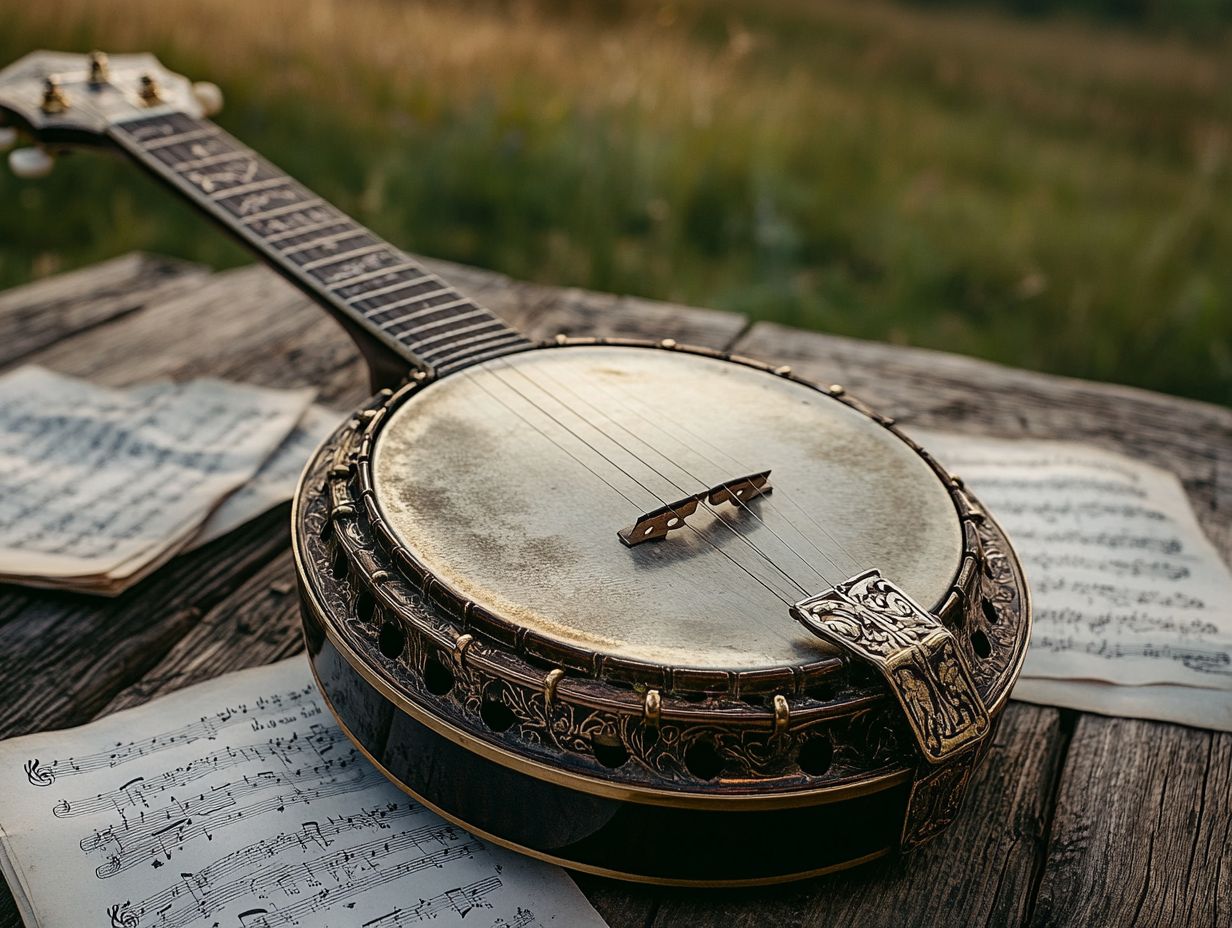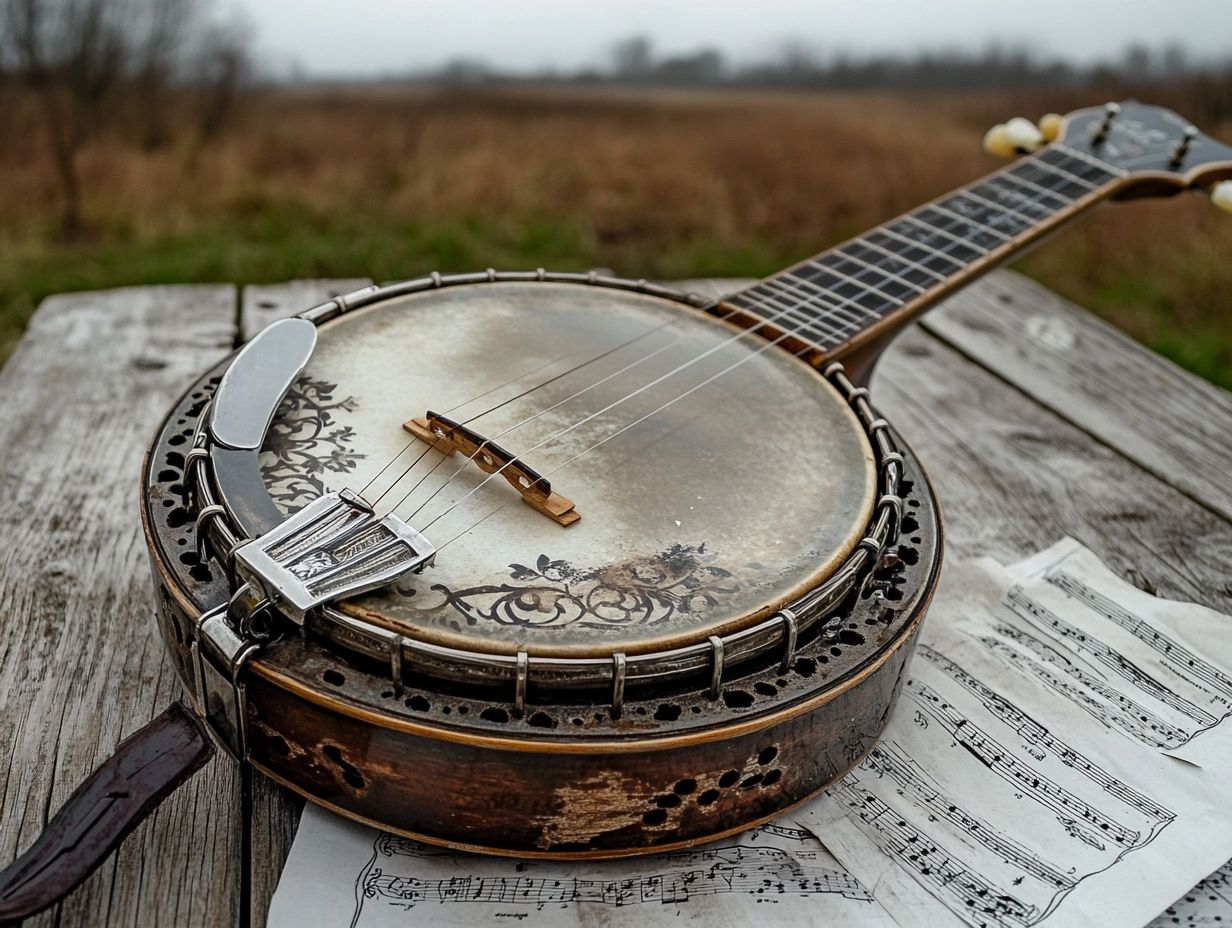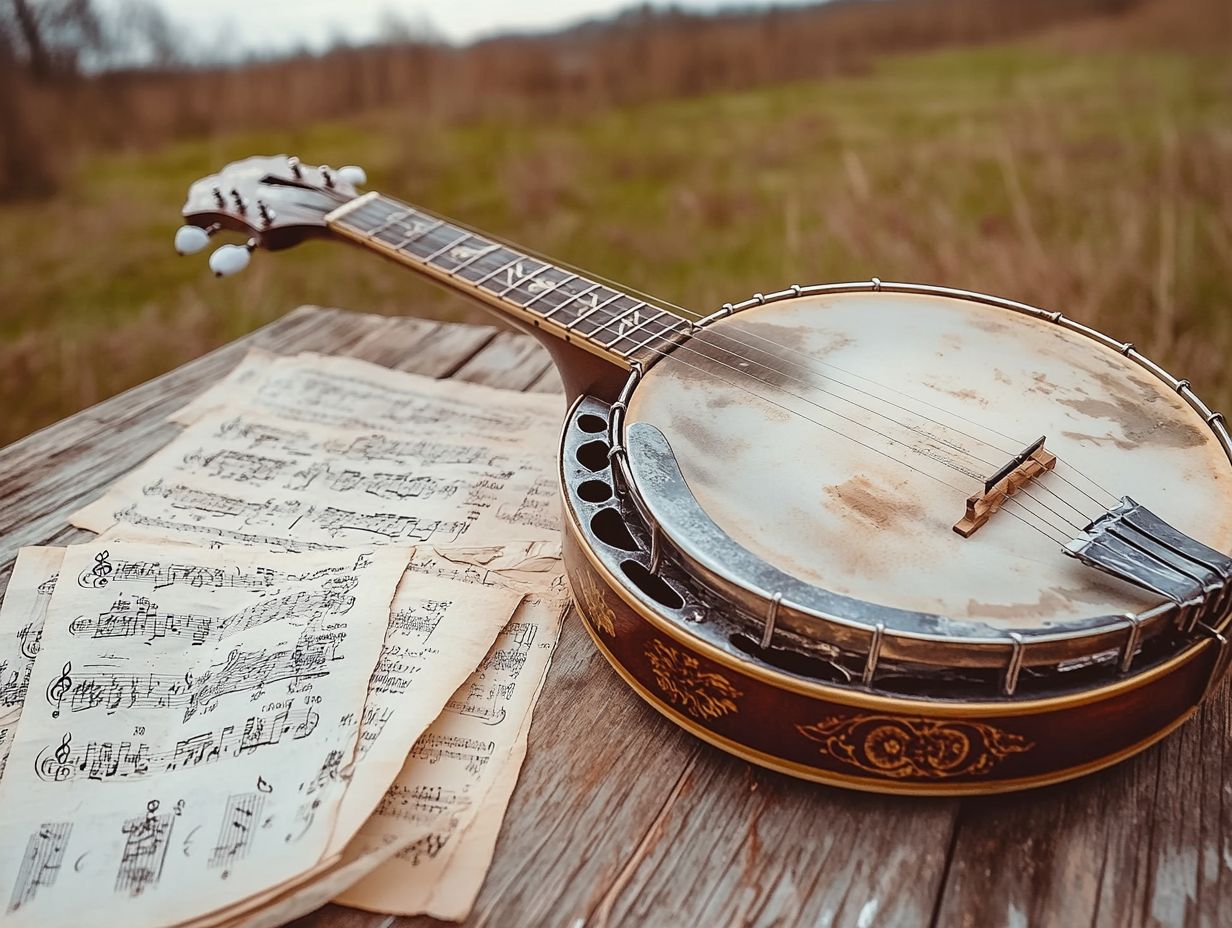The banjo, known for its distinctive twang and rhythmic pulse, has played a crucial role in shaping the sounds of bluegrass and folk music. This article explores the rich history of the banjo, tracing its origins and evolution over time.
It uncovers the unique features and techniques that contribute to the banjo’s signature sound, highlights the contributions of legendary players, and discusses the various types of banjos available.
Whether you are a seasoned musician or a curious beginner, you will find valuable insights on choosing and playing this iconic instrument. Join us in celebrating the banjo’s vibrant legacy and its lasting impact on music today.
Contents
The History of Banjos in Bluegrass and Folk Music

The history of the banjo in bluegrass and folk music dates back to the early 19th century when the instrument was first introduced in America. Originally brought to the country by enslaved Africans, who based it on similar instruments from their homeland, the banjo quickly gained popularity among European settlers.
In the American South, particularly in the Appalachian region, the banjo became an integral part of folk culture and became renowned for its distinctive sound in bluegrass music. The emergence of bluegrass as a distinct genre in the 1940s and 50s propelled the banjo into the spotlight, with artists like Earl Scruggs and Ralph Stanley playing pivotal roles in popularizing the instrument.
Today, the banjo is a staple in both bluegrass music and many folk music traditions, and it continues to feature prominently at bluegrass festivals.
Origins and Evolution
The banjo originated from West African string instruments that were brought to America, where they evolved into various versions of the instrument we see today. Over the years, the craftsmanship of the banjo changed significantly, allowing for the production of different sounds and expressive features, particularly within bluegrass and folk music contexts.
As musicians introduced new playing styles, such as clawhammer and bluegrass picking, the instrument underwent major transformations, each style reflecting its own traditions and contexts. The incorporation of modern materials and improvements in design led to greater volume and resonance, solidifying the banjo’s role in both solo performances and ensemble settings.
Its integration into jazz and country music further showcased the banjo’s versatility, highlighting how the evolution of the instrument paralleled the development of various musical styles and the social contexts of diverse communities.
The Unique Sound of Banjos
Banjos produce a distinctive sound characterized by a twangy and bright tone, making them a popular choice for bluegrass and folk music.
The banjo’s sound is shaped by various playing techniques, such as fingerpicking and strumming patterns, which enhance the instrument’s dynamic range and musical expression.
Distinctive Features and Techniques

Banjo techniques are diverse, with clawhammer and bluegrass fingerpicking styles showcasing the instrument’s versatility and intricate sound. Each technique contributes unique textures to performances, positively influencing the rhythms and melodies of traditional folk music and bluegrass standards.
Clawhammer is characterized by a distinctive strumming motion that produces a rhythmic, percussive quality, resonating deeply with listeners. This style enables the performer to create complex melodic lines while simultaneously maintaining a steady beat, a hallmark of many folk tunes.
In contrast, fingerpicking emphasizes the precision of individual notes, resulting in a brighter, more articulated sound. This technique not only enhances the clarity of melodies, but also allows for intricate harmonies, enriching the overall musical texture.
Famous Banjo Players and Their Contributions
Renowned banjo players have made a significant impact on the sound and perception of the instrument, leaving a lasting influence on the bluegrass and folk music genres.
Legends like Earl Scruggs and Bela Fleck have mastered the banjo, expanded its boundaries, and enhanced its cultural significance by blending traditional techniques with innovative styles.
Notable Musicians and Their Influence
Prominent musicians like Alison Brown and Tony Trischka have played a vital role in the evolution of banjo music, showcasing their technical prowess and engaging in musical collaborations that enrich the storytelling aspect of folk and bluegrass traditions.
Their participation in bluegrass festivals not only allows them to share their own artistic narratives but also provides a platform for new artists to present their stories. Through colorful songwriting, these musicians express personal and cultural experiences that evoke strong emotions and foster a sense of community.
Collaborating with artists from other genres adds an additional layer of sound, honoring the diverse histories and stories inherent in the music. This approach enhances the cultural significance of the genre and inspires future generations to connect with its rich past.
Types of Banjos

The four-string banjo and the five-string banjo are two examples of the various types of banjos, each possessing distinct features that contribute to their unique sound and playability.
Understanding the differences between these banjo types is essential for musicians, as it allows them to select an instrument that best aligns with their playing style and the musical context in which they perform, whether in live music settings or jam sessions.
Differences in Design and Sound
The design differences among various banjos significantly influence their sound quality and suitability for different music genres, such as bluegrass and folk. Key factors, including the materials used in banjo construction, the presence of a resonator, and the level of craftsmanship, play crucial roles in shaping the instrument’s tonal characteristics.
For example, a banjo made from high-quality woods like maple or mahogany may produce a warmer and richer sound, while those constructed from less expensive materials might lack depth. The choice between an open-back banjo and one with a resonator can greatly affect projection and resonance.
Additionally, the subtle nuances in craftsmanship—ranging from the shaping of the neck to the precise fitting of the strings—contribute to the instrument’s performance in various musical settings. This makes certain folk instruments more suitable for intimate gatherings, while others excel in larger performances.
How to Choose the Right Banjo
When choosing a banjo, it is important to consider several factors, including the type of music you wish to play, your level of experience, and the specific features you require in a banjo.
Additionally, aspects such as banjo construction, tuning, and maintenance all influence its playability and your overall enjoyment.
Factors to Consider When Buying

When buying a banjo, the primary factors to consider are craftsmanship, acoustic quality, and cost. Understanding these key elements will help you select an instrument that aligns with your musical goals and personal preferences.
- Craftsmanship: The craftsmanship of a banjo is arguably the most crucial consideration, as it directly impacts the instrument’s playability, tone, and durability. A well-constructed banjo is more likely to offer better playability, a comfortable feel, and excellent sound quality, all of which can enhance a player’s enjoyment and performance.
- Acoustic Quality: Acoustic quality is another significant factor in your decision. Different banjo models produce varying acoustic qualities, which can influence the tone and sound of your performances.
- Cost: Financial considerations also play an important role in your purchase. Establishing a budget will help you find a banjo that meets your goals and desires while remaining within your financial constraints.
By prioritizing these factors, you can choose an instrument that resonates with you on your musical journey.
Learning to Play the Banjo
Learning to play the banjo can be a deeply rewarding experience, offering a unique outlet for folk music while also providing insights into the distinct characteristics of bluegrass culture.
Beginners should focus on mastering basic banjo techniques, understanding music education principles, and recognizing the significance of jam sessions in developing their skills.
Tips and Resources for Beginners
Beginners looking to learn the banjo and improve their skills can benefit from several tips and resources, including understanding the basics of music theory, employing effective practice techniques, and finding a supportive community. Following these strategies can significantly enhance the learning experience.
A good rule of thumb is to practice for a minimum of 30 minutes a day, at least six days a week, to optimize skill development. Additionally, utilizing various platforms, such as YouTube, can provide instructional videos, sheet music, and exercises that teach music theory and the fundamentals of playing the banjo, many of which are often available for free.
Joining a local music group or an online community can also enrich the learning experience by connecting students with other banjo players who share similar goals.
